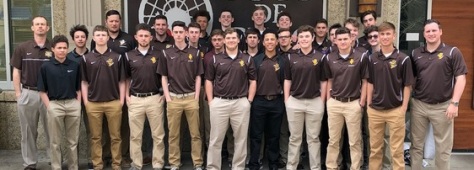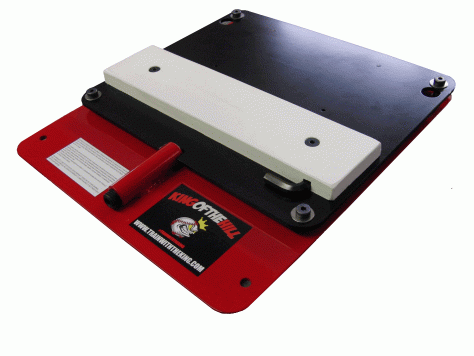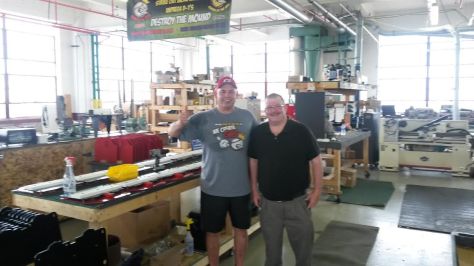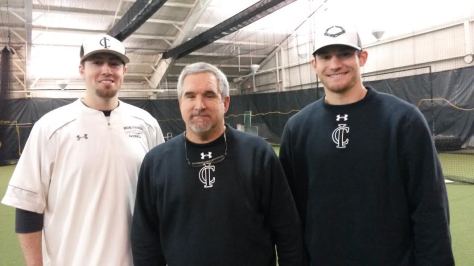
By STEVE KRAH
Speedway (Ind.) High School head baseball coach Marcus McCormick wants his players to pick up the skills to be successful on the diamond.
But that’s not all.
Passing along life skills is very important to the coach and educator.
“It’s our goal to help the young men who come through our program reach whatever goal they’ve set,” says McCormick, who completed his 10th season of leading the Sparkplugs program in 2018. “We try to identify each goal and they try to work to get there.
“We also try to set things in motion so our kids will be great fathers and great husbands.
“The easy stuff is the baseball stuff. That’s pretty easy to teach.”
To be a part of Speedway baseball is to be part of a group that looks after its own.
“We’re one big family,” says McCormick, who had 27 players in the program in 2018 and went 12-12 at the varsity level. The team lost to Cascade in the first round of the IHSAA Class 2A Speedway Sectional.
The Sparkplugs have won eight sectional crowns, including three with McCormick at the helm (2012, 2013 and 2015). Speedway was 2A state runner-up in 2001 with Bruce Hutchings as head coach.
Besides Speedway, the Indiana Crossroads Conference featured Beech Grove, Indianapolis Cardinal Ritter, Indianapolis Lutheran, Indianapolis Scecina, Monrovia, Park Tudor and Triton Central in 2017-18. Each ICC team played one another once on Tuesdays and Wednesdays. In the future, Cascade will replace Park Tudor.
Though none from the Class of ’18 made any commitments, recent Sparkplugs to go on to college baseball include Jacob Bryant (Franklin College), Bryce Pennington (Parkland College), Matt Turk (Marian University) and Jonathan Willoughby (Anderson University).
Besides McCormick, Speedway baseball is guided by assistants J.D. Clampitt (who played at Danville Area Community College in Illinois), Matt Burke (who played at Glen Oaks Community College in Michigan), Eric Mattingly (formerly the head coach at Brownsburg High School), David McCready and Ryan Neat (who played Butler University).
“That is arguably the best coaching staff in the state of Indiana,” says McCormick. “They all work their (posteriors) off from August to June.”
McCormick is a 1990 graduate of North Montgomery High School, where he played basketball for coach Bob Reese.
“He taught me how to prepare for games,” says McCormick of Reese. “He said, ‘if you’re not good enough, you need to be the gym.’ He talked about the little things and the extra stuff.
“But the person I learned the most from was my dad, Tom McCormick. He was the motivator. He’d say, ‘if you don’t like your playing time, then play better.’”
Marcus McCormick played basketball at Marian College (now Marian University) for coach John Grimes.
“He reinforced the work ethic part of it,” says McCormick.
Tom and Gina McCormick, who celebrated their 50th year of marriage in the spring, had three children — Marcus, Erick and Kara. Erick played football and basketball and Kara basketball, including at Marian.
“They were both better athletes than me,” says Marcus McCormick of his siblings. Erick McCormick died in 2005.
While he devoted much time to the hardwood, Marcus always had an affinity for the diamond.
“Baseball was always been my favorite sport growing up,” says McCormick.
He has coached travel baseball for two decades in the summer — first for the Indy Outlaws and now with the Indiana Pony Express.
After one season as a Speedway High assistant, he was encouraged by wife Kelley to apply for the head coaching post.
“Without her, I wouldn’t get to do what I do,” says Marcus of Kelley. “Her support is incredible.”
The McCormicks have two boys. Michael McCormick (24) pitched at Eastern Illinois University and is now in the Chicago White Sox system. Nicholas McCormick (22) was on the EIU baseball team with his brother before transferring to play at Arizona Christian University.
Marcus McCormick has enjoyed picking up coaching advice from other coaches. After attending his first Indiana High School Baseball Coaches Association State Clinic in January 2009, he approached Decatur Central coach Phil Webster after he spoke as a state championship coach from 2008.
“We went to breakfast one day and picked his brain for a couple of hours,” says McCormick of the man who was elected to the IHSBCA Hall of Fame in 2015. “Most coaches are willing to share, it’s just that nobody ever asks them.”
McCormick has developed opinions about pitching and the pitch count rule adopted by the IHSAA in 2017 (1 to 35 pitches requires 0 days rest; 36 to 60 requires 1 day; 61 to 80 requires 2 days; 81 to 100 requires 3 days; and 101 to 120 requires 4 days).
“I get the rule, but it’s disappointing we have to have something in place,” says McCormick. “You’d like to think all the coaches in the state have the kids’ best interest at heart.”
McCormick sees arm care as more of an overall development thing?
“Limiting the number of pitchers you throw is not a precursor for keeping you healthy,” says McCormick. “Why does Kid A get hurt and not Kid B? You have to be doing things to truly recover so the next time you go out you’re putting yourself in a good situation.
“I hope the state incorporates programs like Driveline to keep kids healthy and make them better.”


Speedway (Ind.) High School baseball is a “family” under Sparkplugs head coach Marcus McCormick.







